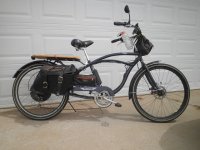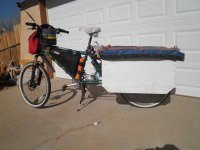kiltedcelt
100 W
Hello,
First time poster here with a lot of completely clueless questions. I've been searching the forum, reading all the noob questions and honestly trying to figure out what I want to do without having to post the type of question that doubtless dozens or hundreds of other posters have asked already. Sadly, I'm completely overwhelmed with the information and don't have a clue where to begin. I do at least know enough (from reading some stickies), to post some of the relevant background information:
Rider weight: 175 lbs.
Bike: Yuba Mundo v. 4.3
Current location: Chicago, Illinois USA (completely flat)
Note: plans to move to Fort Collins, Colorado within the next 10 months or so - so hills/mountains will likely be in the mix by then - good-bye (and good riddance) to flat, boring commutes/rides
Type of riding: Mostly commuting (currently 22+ per day round trip occasionally more with errands in the mix), cargo hauling heavy and/or bulky items, ability to occasionally haul a passenger desired, touring (potentially some off-road or at least on rough trails/roads)
I ride my bike because it's my exercise and also because I no longer own a car and I really hate the cost and inconvenience of mass transit. I *don't* want an ebike so that I can just turn a throttle and cruise without pedaling, in fact I think most of the time I wouldn't be using the motor unless I was heavily overloaded, or on the days where I'm commuting into work and facing 20-30+ mph headwinds. I'm most interested in what I'm guessing is a pedal-assist kind of motor setup and not really needing to go any faster than 20 mph is fine with me. I'm a competent bicycle mechanic and I built my Yuba Mundo from the bare frame up, with a mix of completely custom components steps well above the quality of a stock Yuba. I do know that I'm mainly interested in a mid-drive motor as I have built my own custom wheels around a Deore LX dynamo front hub and a strong 36 spoke Deore rear hub. The bike currently uses Avid BB7 disc brakes.
I did get a chance to ride a Felt fatbike that uses the Bosch mid drive motor and love the feel of how the motor comes on and just gives you a slight boost to your pedaling without being overly obtrusive. I also liked the different levels of settings for the amount of assist. If possible, I'd like to duplicate that feel in whatever aftermarket kit I eventually choose. Also, a few other criteria I've noticed in reading about the different motors.
1. The entire set up needs to be as durable and waterproof as possible. I will ride in torrential downpours on occasion because I have no other choice. I don't want a motor/controller/battery set up that is going to get ruined because water somehow got into it. Likewise, I will ride in snow and extreme cold too, so the whole apparatus needs to withstand those temperature extremes as well.
2. Because of a hip issue, I utilize slightly shorter than normal crank arms (they're 153mm), to limit range of motion in my hips, so I'd prefer to be able to continue to utilize my own crank arms with any kit.
3. I prefer the Avid "Speed Dial" brake levers in order to tailor the amount of brake modulation that I have, so if possible I'd like to stick with the Avid levers. Is there a kind of motor cut-off sensor that can be installed on existing levers without having to switch to some kind of proprietary lever?
4. For durability's sake I use stainless steel chainrings on my crankset, and I want to maintain the ability to use my full range of gearing whether the motor is in use or not, which I guess eliminates some kits that have their own propriety cranksets.
Finally, budget I guess. I just don't know what I should be looking at. I *do* know that a full-on Stokemonkey or Bionix kit are completely out - WAY too expensive. I can build my own battery if it comes to that for helping to curb the cost. I could stomach a few hundred for the motor/controller/charger so I guess maybe as long as things don't get too far above $1000 or so. Is it even possible to build and install a mid drive motor that is durable and not complete junk for less than $1000 including battery? Again, I simply don't even know if this is possible and the sheer amount of information is overwhelming as to where to begin. If you've read this far, thanks, I appreciate your patience and look forward to reading your suggestions.
First time poster here with a lot of completely clueless questions. I've been searching the forum, reading all the noob questions and honestly trying to figure out what I want to do without having to post the type of question that doubtless dozens or hundreds of other posters have asked already. Sadly, I'm completely overwhelmed with the information and don't have a clue where to begin. I do at least know enough (from reading some stickies), to post some of the relevant background information:
Rider weight: 175 lbs.
Bike: Yuba Mundo v. 4.3
Current location: Chicago, Illinois USA (completely flat)
Note: plans to move to Fort Collins, Colorado within the next 10 months or so - so hills/mountains will likely be in the mix by then - good-bye (and good riddance) to flat, boring commutes/rides
Type of riding: Mostly commuting (currently 22+ per day round trip occasionally more with errands in the mix), cargo hauling heavy and/or bulky items, ability to occasionally haul a passenger desired, touring (potentially some off-road or at least on rough trails/roads)
I ride my bike because it's my exercise and also because I no longer own a car and I really hate the cost and inconvenience of mass transit. I *don't* want an ebike so that I can just turn a throttle and cruise without pedaling, in fact I think most of the time I wouldn't be using the motor unless I was heavily overloaded, or on the days where I'm commuting into work and facing 20-30+ mph headwinds. I'm most interested in what I'm guessing is a pedal-assist kind of motor setup and not really needing to go any faster than 20 mph is fine with me. I'm a competent bicycle mechanic and I built my Yuba Mundo from the bare frame up, with a mix of completely custom components steps well above the quality of a stock Yuba. I do know that I'm mainly interested in a mid-drive motor as I have built my own custom wheels around a Deore LX dynamo front hub and a strong 36 spoke Deore rear hub. The bike currently uses Avid BB7 disc brakes.
I did get a chance to ride a Felt fatbike that uses the Bosch mid drive motor and love the feel of how the motor comes on and just gives you a slight boost to your pedaling without being overly obtrusive. I also liked the different levels of settings for the amount of assist. If possible, I'd like to duplicate that feel in whatever aftermarket kit I eventually choose. Also, a few other criteria I've noticed in reading about the different motors.
1. The entire set up needs to be as durable and waterproof as possible. I will ride in torrential downpours on occasion because I have no other choice. I don't want a motor/controller/battery set up that is going to get ruined because water somehow got into it. Likewise, I will ride in snow and extreme cold too, so the whole apparatus needs to withstand those temperature extremes as well.
2. Because of a hip issue, I utilize slightly shorter than normal crank arms (they're 153mm), to limit range of motion in my hips, so I'd prefer to be able to continue to utilize my own crank arms with any kit.
3. I prefer the Avid "Speed Dial" brake levers in order to tailor the amount of brake modulation that I have, so if possible I'd like to stick with the Avid levers. Is there a kind of motor cut-off sensor that can be installed on existing levers without having to switch to some kind of proprietary lever?
4. For durability's sake I use stainless steel chainrings on my crankset, and I want to maintain the ability to use my full range of gearing whether the motor is in use or not, which I guess eliminates some kits that have their own propriety cranksets.
Finally, budget I guess. I just don't know what I should be looking at. I *do* know that a full-on Stokemonkey or Bionix kit are completely out - WAY too expensive. I can build my own battery if it comes to that for helping to curb the cost. I could stomach a few hundred for the motor/controller/charger so I guess maybe as long as things don't get too far above $1000 or so. Is it even possible to build and install a mid drive motor that is durable and not complete junk for less than $1000 including battery? Again, I simply don't even know if this is possible and the sheer amount of information is overwhelming as to where to begin. If you've read this far, thanks, I appreciate your patience and look forward to reading your suggestions.




